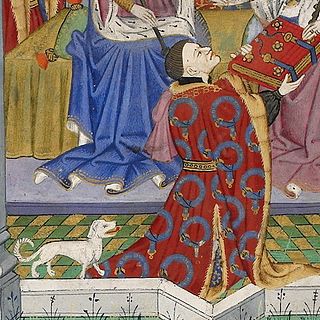
Graves is an important subregion of the Bordeaux wine region. Graves is situated on the left bank of the Garonne River, in the upstream part of the region, southeast of the city Bordeaux and stretches over 50 kilometres (31 mi). Graves is the only Bordeaux subregion which is famed for all three of Bordeaux' three main wine types—reds, dry whites and sweet wines—although red wines dominate the total production. Graves AOC is also the name of one Appellation d'origine contrôlée (AOC) which covers most, but not all of the Graves subregion.

Château Margaux, archaically La Mothe de Margaux, is a wine estate of Bordeaux wine, and was one of four wines to achieve Premier cru status in the Bordeaux Classification of 1855. The estate's best wines are very expensive, with a standard-sized bottle of the Château Margaux grand vin retailing at an average price of $639. The estate is located in the commune of Margaux on the left bank of the Garonne estuary in the Médoc region, in the département of Gironde, and the wine is delimited to the AOC of Margaux.
Château Lynch-Bages is a winery in the Pauillac appellation of the Bordeaux region of France. Château Lynch-Bages is also the name of the red wine produced by this property. The wine produced here was classified as one of eighteen Cinquièmes Crus in the Bordeaux Wine Official Classification of 1855.
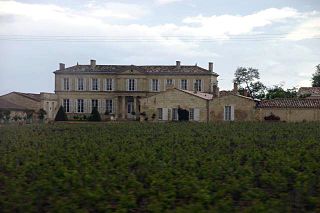
Château Branaire is a winery in the Saint-Julien appellation of the Bordeaux region of France. Château Branaire is also the name of the main red wine produced by this property and which was classified as one of the ten 'Fourth Growths' in the Bordeaux Wine Official Classification of 1855.

Château Lagrange is a winery in the Saint-Julien appellation of the Bordeaux region of France, and is also the name of the red wine produced by this property. It is owned by the Japanese liquor giant Suntory. The wine produced here was classified as one of fourteen Troisièmes Crus in the historic Bordeaux Wine Official Classification of 1855.

A Bordeaux wine is any wine produced in the Bordeaux region of southwest France. Bordeaux is centered on the city of Bordeaux, on the Garonne River. To the north of the city the Dordogne River joins the Garonne forming the broad estuary called the Gironde and covering the whole area of the Gironde department,with a total vineyard area of over 120,000 hectares, making it the largest wine growing area in France. Average vintages produce over 700 million bottles of Bordeaux wine, ranging from large quantities of everyday table wine, to some of the most expensive and prestigious wines in the world. The vast majority of wine produced in Bordeaux is red, with sweet white wines, dry whites, and rosé and sparkling wines collectively making up the remainder. Bordeaux wine is made by more than 8,500 producers or châteaux. There are 54 appellations of Bordeaux wine.

Château Pontet-Canet is a winery in the Pauillac appellation of the Bordeaux wine region of France. Chateau Pontet-Canet is also the name of the red wine produced by this property. The wine produced here was classified as one of eighteen Cinquièmes Crus in the Bordeaux Wine Official Classification of 1855.
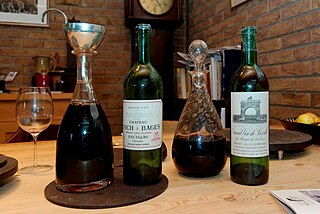
Château Léoville-Las Cases is a winery in the Saint-Julien appellation of the Bordeaux region of France. Château Léoville-Las Cases is also the name of the red wine produced by this property. The wine produced here was classified as one of fifteen Deuxièmes Crus in the original Bordeaux Wine Official Classification of 1855.
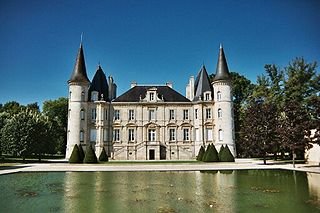
Château Pichon Longueville Baron or Château Longueville au Baron de Pichon-Longueville is a winery in the Pauillac appellation of the Bordeaux region of France. Château Pichon Longueville Baron is also the name of the red wine produced by this property. The wine produced here was classified as one of fifteen Deuxièmes Crus in the original Bordeaux Wine Official Classification of 1855.

Château Gruaud-Larose is a winery in the Saint-Julien appellation of the Bordeaux region of France. It is also the name of the red wine produced by this property. The wine produced here was classified as one of fifteen Deuxièmes Crus in the original Bordeaux Wine Official Classification of 1855.
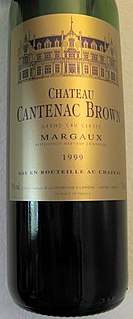
Château Cantenac-Brown is a winery in the Margaux appellation of the Bordeaux region of France. The wine produced here was classified as one of fourteen Troisièmes Crus in the historic Bordeaux Wine Official Classification of 1855. The Château has 118 acres (0.48 km2) planted with Cabernet Sauvignon, Merlot and Cabernet Franc. The Château produces a second wine labeled as Brio de Cantenac-Brown.

Château La Tour Carnet is a Bordeaux wine estate in the appellation Haut-Médoc. The wine produced here was classified as one of ten Quatrièmes Crus in the historic Bordeaux Wine Official Classification of 1855, at the time known by the name of Carnet.

Château Dauzac is a winery in the Margaux appellation of the Bordeaux region of France, in the commune of Labarde. The wine produced here was classified as one of eighteen Cinquièmes Crus in the Bordeaux Wine Official Classification of 1855. Since 1988, the estate has belonged to the insurance company MAIF, but is managed by the André Lurton group. In 2004, his daughter Christine Lurton-Bazin de Caix took charge of the property.

Château Saint-Pierre is a winery in the Saint-Julien appellation of the Bordeaux region of France. The wine produced here was classified as one of ten Quatrièmes Crus Classés in the historic Bordeaux Wine Official Classification of 1855.

Château Lafaurie-Peyraguey is a Premier Cru Classé Sauternes wine from the Sauternes appellation. The winery is located in the southern part of France’s Bordeaux wine region in the district of Graves in the commune of Bommes, and its château is situated on a hill top facing Sauternes' highest classed vineyard, Château d'Yquem.

Château Sigalas-Rabaud, previously also named Château Rabaud-Sigalas, is a Bordeaux wine producer in the Sauternes appellation. Its sweet white wine ranked as Premier Cru Classé in the original Bordeaux Wine Official Classification of 1855. It is located in the commune of Bommes in the region of Graves. It was once joined with Château Rabaud-Promis in the estate named Château Rabaud. With only 14 hectares, Château Sigalas-Rabaud is the smallest of all crus classés of the 1855 classification.
Château Doisy Daëne is Bordeaux wine producer located in the commune of Barsac. Its sweet white wine ranked as Second Cru Classé in the original Bordeaux Wine Official Classification of 1855. It belongs to the Sauternes appellation in Gironde, in the region of Graves.
Château Pape Clément is a Bordeaux wine from the Pessac-Léognan appellation, ranked among the Crus Classés for red and white wine in the Classification of Graves wine of 1959. It is the oldest wine estate in Bordeaux, harvesting its 700th vintage in 2006. The winery and vineyards are located in the commune of Pessac, south-west of the city of Bordeaux. When the estate was omitted from the initial Graves classification of 1953 it caused some controversy.

Château Malartic-Lagravière, originally Domaine de Lagravière, is a Bordeaux wine from the Pessac-Léognan appellation, ranked among the Crus Classés for red and white wine in the Classification of Graves wine of 1953 and 1959. The winery and vineyards are located south of the city of Bordeaux, in the commune of Léognan.

Château La Louvière is a Bordeaux wine producer from the Pessac-Léognan appellation of Bordeaux. The château is located in the commune of Léognan. Château La Louvière is owned by André Lurton since 1965.





